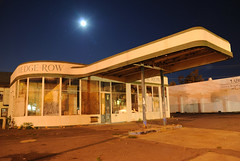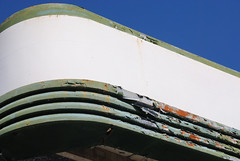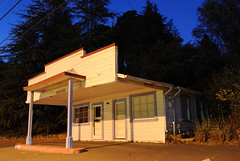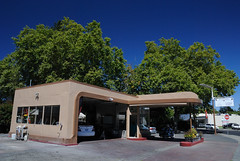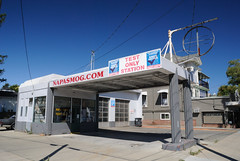
"If only . . . ." There are at least a dozen sentences beginning with that phrase that my wife and I find ourselves muttering morosely these days in relation to our first ever bid on a house. It was ours! It should be ours! It was perfect for us, and we were perfect for it! But it will never be ours, and finding something else even close to it is a decidedly remote possibility.

(Walking up the front path.)
We had only been house shopping for four days and had already seen a house that was almost exactly what we were looking for--except for the location--when our real estate agent showed us this 1920 Craftsman house. We weren't looking for a house like this, but only because this house was so much more than we could have imagined we could find in our budget!

(Garden sheds on the property.)
On a quiet street, just under 1/2 mile from the Oxbow Public Market (my favorite thing about Napa), .7 miles from First and Main Street downtown, and two blocks from one of the best schools in town and its playgrounds, this house sits on a double lot. If you look closely, you can see that the lot is elaborately landscaped, but at first glance it just appears overgrown. The old two-car garage is hard to miss, but you have to hunt around to find all the structures--the two picturesque sheds, an artist's studio (with electricity), and a small playhouse.

(From the porch.)
On our first visit, we strolled up the front sidewalk, climbed the stairs to a small, but serviceable, porch, and went in the door to be blown away. Beautiful, original woodwork everywhere and a massive built-in so typical of Craftsman houses, all of it looking like the day it was first finished. The rest of the house didn't live up to the front room, but it was plenty good enough.


(The exciting front room!)
The kitchen was barely existent: a very small counter with cabinetry underneath (no upper cabinets, no more counter space), an odd hutch built to enclose the refrigerator, and a stove. But there was plenty of space to put in a proper kitchen and dining area, and a great piece to build it around-- a restored ca. 1950 Wedegwood stove. In the days after our visit my wife spent a good amount of time shopping for retro-styled refrigerators that would have complemented that stove.


(The kitchen.)
Behind the kitchen was another very small kitchen--perhaps the original 1920 kitchen. All that was missing was the old wood-burning stove, and we found two of those later in the basement, one of which had likely originally been in that kitchen, and which we would have restored to its proper place (for show only).

(The old kitchen.)
Next to the old kitchen was the bathroom. Like the kitchen it was incomplete, with no sink. But like the kitchen it had something great to build around, a huge, cast-iron, claw-foot tub (like my wife has always wanted).

(The bathroom.)
Next up, we saw the basement. It was a full basement, so there was plenty of room, albeit not much headroom. Its other major drawback was that it could only be accessed via an outside door. In this large basement there was a modern bathroom with plenty of storage (and yes, even a sink) and a partially finished area that would have become our guest bedroom. There were also stored lots of odds and ends from the house's 93-year history, including the aforementioned wood-burning stoves, one of which was hooked up to the chimney for heat downstairs.
Did I mention there was no central heating?

(Downstairs entry and heating system.)
Yes, we would have had to do considerable work to the house: add central heating, put in a kitchen, and redo the upstairs bathroom, and add a stairway down to the basement so that area could be better utilized and integrated. But we didn't want to change the character of the house or update things that were actually working fine--no stainless steel appliances, granite counter tops, or master bedroom suites for us. Heck, I was even fine with having to bend down to walk through the basement. And the asking price for the house was well within our range.

(A surprise bathroom downstairs!)
But between the price of the house and the price of the renovations, it would have cost us all that we had decided was our maximum house budget. The result, however, would have been a house worth much more than that what we would have spent--a showcase historic home on a huge lot right in the heart of town! A house to show off to guests and the community, and a jewel to pass on to our daughter.

(The original stove?)
We thought the property was definitely worth what the seller was asking, but given that we were going to put everything we had to spend into it and that you never can be sure exactly how much those renovation will add up to, we wanted to save on the purchase price if we could, so when our agent suggest we offer $25k less than the asking price, we followed the advice. The seller came back with an offer $2k less than the original asking price. It was our move.

(Master bedroom.)
I was so excited about the property that I started researching its history. Presumably the first owner of the house was the immigrant living there in 1925, Domenico Abate. Born in Italy in 1883, he was a wholesaler at Napa Milling and Wholesale Co. and lived in the house up until his death in 1969. His son George went on to be come the Napa County Assessor, while his daughter Anne Mary Abate owned the house until 1980--meaning the house spent its first 60 years all in one Italian immigrant's family. I was looking forward to discovering forgotten items from the house's long history scattered about the property over the years.

(Playhouse.)
But back to the negotiations. We agreed on Friday night to accept the counter-offer, but instead of sending off the message to our agent, we decided to sleep on it and view the house again in the morning before letting him know our response. We were thinking of the place as pretty much ours at this point. It was just a matter of whether we wanted to haggle over a couple of thousand dollars--but then we needed every penny for the renovations. And ultimately we decided to change our offer to $7k less than the original asking price, rather than accept the counter offer for $5k more.

(The artist's studio.)
We didn't know it, because the listing agent, going against form, did not tell us that another bid had been received by that point. Had we known this vital bit of information, we would have accepted the counter offer and I'd be out getting better photos of our new house right now instead of writing about our bitter failure.
Our offer was rejected and the new one--full price, cash, no contingencies (likely an investor who will look to flip the house)--was accepted.
